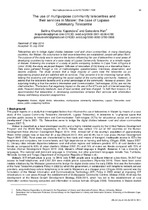| dc.contributor.author | Kapondera, Sellina Khumbo | |
| dc.contributor.author | Hart, Genevieve | |
| dc.date.accessioned | 2017-04-19T07:45:07Z | |
| dc.date.available | 2017-04-19T07:45:07Z | |
| dc.date.issued | 2016 | |
| dc.identifier.citation | Kapondera, S. K. & Hart, G. (2016). The use of multipurpose community telecentres and their services in Malawi: the case of Lupaso Community Telecentre. South African Journal of Library and Information Science, 82(1): 13-25 | en_US |
| dc.identifier.issn | 0256-8861 | |
| dc.identifier.uri | http://hdl.handle.net/10566/2743 | |
| dc.identifier.uri | http://dx.doi.org/10.7553/82-1-1589 | |
| dc.description.abstract | Telecentres aim to bridge digital divides between rural and urban communities. In many developing countries, like Malawi, the assumption is that once telecentres are established, people will adopt them. The purpose of the study was to examine the factors influencing the use of telecentres in rural areas of developing countries by means of a case study of Lupaso Community Telecentre, in a remote region of Malawi. Following the example of a study of public computing facilities in Cape Town (Chigona & Licker 2008), the study employed Rogers' Diffusion of Innovation (DOI) theory as a theoretical frame. Data were gathered through a mix of methodologies: questionnaires, interviews, observation, and records analysis. The study reveals that a large majority of users view the telecentre as an empowering project and are satisfied with its services. They perceive it to be improving human skills, helping the economy and strengthening the social capital of the surrounding community. However, it seems that the telecentre benefits only a small percentage of the community. Access is uneven. One surprising finding is that the centre's Information and Communication Technologies (ICTs) are not the chief attraction. The factors that negatively impact on the use of the ICTs are lack of internet searching skills, frequent electricity blackouts, lack of local content, and fees charged. To fulfil their mission, it is recommended that telecentres in developing communities enhance their services with information literacy and literacy education programmes. | en_US |
| dc.language.iso | en | en_US |
| dc.publisher | LIASA | en_US |
| dc.rights | The South African Journal of Libraries and Information Science is an Open Access journal which means that all content is freely available without charge to the user or his/her institution. Users are allowed to read, download, copy, distribute, print, search, or link to the full texts of the articles, or use them for any other lawful purpose, without asking prior permission from the publisher or the author (see http://www.sherpa.ac.uk/romeo/search.php). This is in accordance with the BOAI definition of Open Access. | |
| dc.subject | Malawi | en_US |
| dc.subject | Digital divide | en_US |
| dc.subject | Telecentres | en_US |
| dc.subject | Multipurpose community telecentres | en_US |
| dc.subject | Lupaso Telecentre | en_US |
| dc.subject | Rural areas | en_US |
| dc.subject | Public computing facilities | en_US |
| dc.title | The use of multipurpose community telecentres and their services in Malawi: the case of Lupaso Community Telecentre | en_US |
| dc.type | Article | en_US |
| dc.privacy.showsubmitter | FALSE | |
| dc.status.ispeerreviewed | TRUE | |
| dc.description.accreditation | DHET | en_US |

